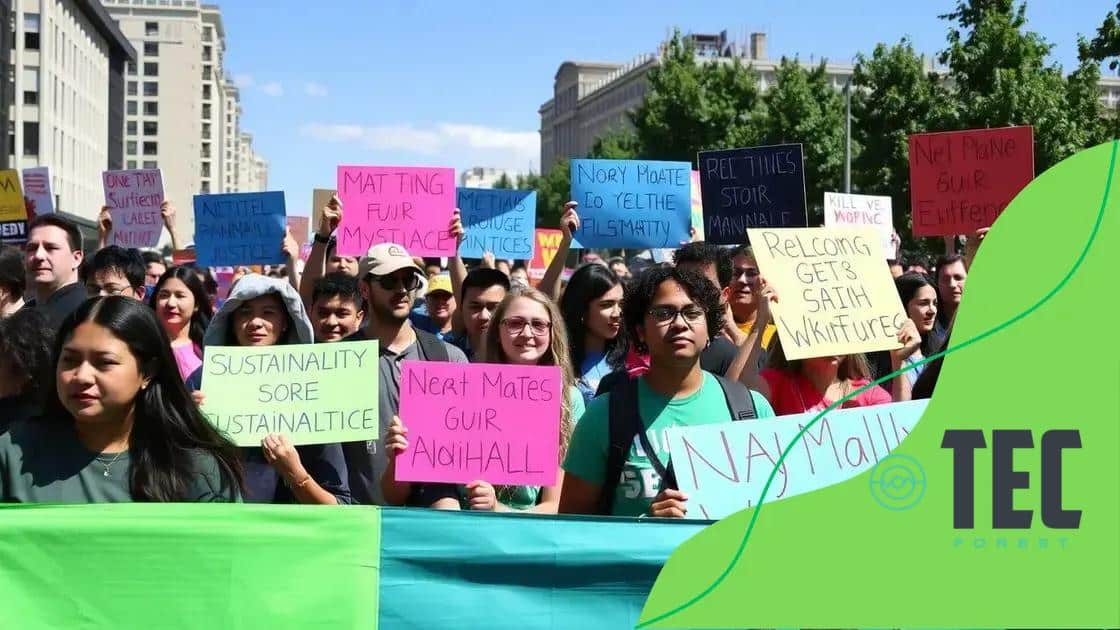Advertisement
Global youth movements demand green economic reforms to address climate change, influencing policies, promoting renewable energy solutions, and advocating for sustainable practices through activism and social media engagement.
Global youth movements demand green economic reforms as young people increasingly recognize the urgent need for change. Their passion and dedication are reshaping conversations around sustainability, urging leaders to take action. How are these movements influencing the future of our planet?
Advertisement
The rise of youth activism for environmental change
The rise of youth activism for environmental change is transforming our world. Young people today are not just passive observers; they are passionate advocates for the future of our planet. With growing awareness of air pollution, climate change, and loss of biodiversity, youth movements are stepping up to demand action from leaders and corporations.
Understanding Youth Activism
At its core, youth activism involves engagement in social and political issues, particularly those concerning the environment. Young activists are utilizing various platforms to voice their concerns and propose solutions. They are organizing rallies, participating in campaigns, and leveraging social media to spread their messages.
Advertisement
Effective Strategies Used by Youth Activists
These activists are employing innovative strategies to capture attention and galvanize support:
- Social Media Campaigns: Platforms like Instagram and TikTok allow youth to share their message widely and quickly.
- Grassroots Movements: Local initiatives are gathering like-minded individuals to create impactful community actions.
- Educational Workshops: Young leaders are conducting workshops to inform peers about environmental issues.
One powerful example is the Fridays for Future movement, sparked by Greta Thunberg. This initiative encourages students to strike from school to draw attention to climate issues, demonstrating the power of youth-led activism in shaping public discourse.
The combination of enthusiasm and creativity among young activists is paving the way for significant changes. Their efforts are pushing governments to reconsider policies and prioritize sustainability. As they continue to advocate for environmental reforms, they are inspiring generations to come to join the cause.
Key demands of global youth movements

Global youth movements are rising with strong demands for change. These young activists are passionate about addressing environmental issues and are calling for immediate action. Their key demands focus on sustainable development, renewable energy, and climate justice.
Sustainable Practices
One of the primary demands is for governments and corporations to adopt sustainable practices. This involves using resources that do not deplete the environment. Young people are advocating for:
- Reduction of single-use plastics: Many youth organizations are pushing for laws to limit plastic production.
- Promoting circular economies: This includes recycling and restoring instead of wasting.
- Supporting sustainable agriculture: Emphasizing the importance of local and organic food systems.
These practices are essential to ensuring a healthy planet for future generations.
Renewable Energy Initiatives
Another main focus area is the transition to renewable energy. Youth activists are calling for investments in clean energy sources like solar, wind, and geothermal. They believe that a shift from fossil fuels to renewables is crucial for battling climate change. Many are urging local governments to:
- Increase funding for renewable projects: This can help create jobs and reduce carbon emissions.
- Implement tax incentives: Encouraging companies to develop green technologies.
- Promote energy efficiency: Educating the community on reducing energy consumption.
By advocating for renewable energy, these movements are taking a significant step towards a sustainable future.
Climate Justice
Finally, the demand for climate justice cannot be overlooked. Young activists emphasize that climate change disproportionately affects marginalized communities. They call for:
- Inclusive policies: Ensuring that all voices, especially those of impacted groups, are heard in decision-making.
- Support for vulnerable populations: Providing aid and resources to communities hit hardest by climate change.
- Education and awareness: Equipping people with knowledge about climate-related issues.
These demands showcase the commitment of global youth movements to create a more equitable and sustainable world.
Successful examples of youth-led green initiatives
Many successful examples of youth-led green initiatives demonstrate how young people are making a significant impact on the environment. These initiatives showcase innovation, dedication, and the ability to inspire communities. From urban gardens to global climate strikes, youth are taking charge of their future.
Community Gardens
One effective example is the rise of community gardens. Young activists are transforming vacant lots into green spaces where they grow organic vegetables and flowers. These gardens not only promote sustainability but also foster community spirit. They help:
- Provide fresh produce: Community members have access to healthy food.
- Reduce carbon footprint: Local food production cuts down on transportation emissions.
- Educate others: Workshops teach sustainable gardening practices.
Through these gardens, youth are showing that small actions can lead to big changes.
Climate Strikes
Another powerful youth-led initiative is the organizing of climate strikes. Inspired by activists like Greta Thunberg, students worldwide participate in Fridays for Future events. These strikes aim to raise awareness about the climate crisis and pressure governments to act. By walking out of schools, young people effectively communicate their urgency for action. They often use:
- Art and creativity: Creating banners that convey strong messages.
- Social media campaigns: Mobilizing peers and spreading their message globally.
- Collaborative efforts: Partnering with local organizations to amplify their voices.
The impact of these strikes resonates beyond the streets, sparking conversations that influence policy changes.
Renewable Energy Projects
Youths are also taking strides in renewable energy projects. Many students are advocating for their schools to invest in solar panels or wind turbines. They understand the importance of shifting to clean energy sources. These projects help:
- Reduce energy bills: Schools save money by using renewable sources.
- Promote awareness: Students learn about the benefits of clean energy.
- Inspire action: Other schools adopt similar initiatives.
Through these efforts, youth are proving that they are capable of leading the charge toward a greener future.
The role of social media in mobilizing youth

The role of social media in mobilizing youth is significant and transformative. Platforms like Instagram, Twitter, and TikTok have become essential tools for young activists. They connect people worldwide and amplify their voices on critical issues.
Connecting Communities
Social media enables youth to connect with others who share similar concerns. It helps them find communities that might not exist in their local areas. By participating in online forums and groups, youths can exchange ideas and strategies on activism. This connectivity makes movements stronger.
Spreading Awareness
Another crucial role of social media is spreading awareness about pressing issues. Young people use their platforms to share information and educate their peers about climate change, social justice, and equality. They often:
- Create informative posts: Short videos or infographics grab attention quickly.
- Use hashtags: Popular hashtags, like #FridaysForFuture, help rally support.
- Share personal stories: Authentic narratives resonate with others, inspiring action.
As their messages reach wider audiences, they build momentum and encourage collective action.
Organizing Events
Social media is also essential for organizing events. Young activists can quickly plan protests, rallies, or online campaigns. They share details through posts and event pages, making it easy for supporters to get involved. This rapid dissemination of information allows teams to:
- Coordinate logistics: Timely updates help everyone stay informed.
- Engage followers: Interactive content boosts participation and excitement.
- Network with organizations: Collaborating with NGOs and local groups can enhance impact.
By utilizing social media effectively, youth movements can mobilize large groups of people for important causes.
Impacting Policy Changes
The impact of social media goes beyond activism; it also influences policy changes. When young people share their demands and concerns online, they draw attention from media outlets and policymakers. Their collective voice urges decision-makers to take action. Examples include:
- Public petitions: Online petitions gain signatures quickly, demonstrating support for various causes.
- Calling out leaders: Youth can hold politicians accountable through criticism on social media.
- Facilitating discussions: Encouraging dialogue about important issues creates pressure for change.
As youth continue to harness the power of social media, their influence on society will grow.
Future implications of youth-driven green reforms
The future implications of youth-driven green reforms are vast and significant. As young people continue to champion environmental issues, their actions will shape policies and create lasting changes in society. These reforms not only address immediate concerns but also lay the groundwork for sustainable practices in various sectors.
Policy Changes and Legislation
One primary implication of these reforms is the potential for substantial policy changes. Young activists are dedicated to advocating for laws that prioritize environmental protection and sustainability. They work tirelessly to influence lawmakers, pushing for:
- Tougher regulations: Implementing stricter laws on pollution and carbon emissions.
- Incentives for green technology: Supporting financial benefits for businesses that adopt eco-friendly practices.
- International cooperation: Encouraging global agreements to combat climate change effectively.
This engagement in policy-making can result in a more responsive government that recognizes the importance of a healthy planet.
Shifts in Consumer Behavior
Another important implication involves shifts in consumer behavior. As youth advocate for environmental reforms, they promote awareness of sustainability. Many young people are influencing markets by prioritizing eco-friendly products over traditional options. This trend leads to:
- Increased demand for sustainable goods: More companies are producing green products to meet consumer preferences.
- Support for local businesses: Young consumers are increasingly choosing local goods that minimize carbon footprints.
- Circular economy practices: Encouraging recycling and reusing in everyday decisions.
As consumer habits evolve, businesses will respond, leading to more sustainable economies.
Innovations in Technology
Additionally, youth-driven green reforms pave the way for innovations in technology. There is a growing emphasis on developing solutions that reduce environmental impact. Many young entrepreneurs are at the forefront of creating:
- Clean energy alternatives: Innovations like solar panels and wind turbines are becoming more efficient and accessible.
- Smart technologies: These help individuals and businesses monitor energy usage and reduce waste.
- Biodegradable materials: New products are being developed that break down naturally, reducing landfill waste.
These advancements not only help in combating climate change but also create job opportunities for the next generation.
Global Youth Engagement
The future will also see increased global youth engagement in environmental issues. Young people are becoming more connected through social media, sharing ideas and strategies internationally. This sense of unity inspires:
- Cultural exchanges: Learning from diverse cultures can influence sustainable practices.
- Collaborative initiatives: Joint projects across borders can address global issues effectively.
- Empowerment of marginalized voices: Creating spaces for diverse perspectives leads to more inclusive solutions.
Through collaboration and engagement, today’s youth can drive powerful change for a better tomorrow.
FAQ – Frequently Asked Questions about Global Youth Movements and Environmental Reforms
What role do youth activists play in environmental reforms?
Youth activists are leading movements that push for sustainable practices, policy changes, and increased awareness about environmental issues.
How does social media impact youth engagement in environmental issues?
Social media connects young activists, enabling them to share information, organize events, and raise awareness about critical environmental topics.
What are some successful examples of youth-led green initiatives?
Examples include community gardens, climate strikes, and campaigns promoting renewable energy solutions, all driven by the passion of young people.
How can youth movements influence government policies?
Through their activism and advocacy, youth movements can raise public awareness and pressure lawmakers to adopt environmental regulations and reforms.
